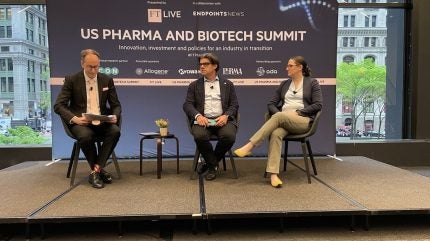Patient access to medicines must be the focus of US drug pricing policy
16 May 2024

Preview
Source: Pharmaceutical Technology
From left to right: moderator, Michael Peel, Science editor at Financial Times; John O’Brien, president and CEO of National Pharmaceutical Council; Sarah Emond, president and CEO of Institute for Clinical and Economic Review. Credits: Justine Ra/GlobalData.
While innovation has continued to advance with the arrival of CRISPR-based gene therapies and the boom of GLP-1 agonists, the sometimes unsustainable and unaffordable nature of drugs is tipping the balance within the drug development and marketing ecosystem, two experts at the Financial Times Live US Pharma and Biotech Summit said.
Both were speaking at a panel on the problems of US drug pricing at the conference, which took place on 16 May in New York.
There is a disconnect between benefits and expenditure such that healthcare spending is slowly occupying increasing portions of employer budgets without people seeing the commensurate impacts or increases in life expectancy in return, said Sarah Emond, president and CEO of Institute for Clinical and Economic Review. The affordability of drugs has been an ongoing concern, and when solutions originating from comprehensive discussions about balancing innovation signals with affordability are not brought to the table, the result is a “blunt force trauma” solution such as the Inflation Reduction Act (IRA), she said.
What the ecosystem needs is a transparent way of assessing value that brings stakeholders together, Emond said. Pharma has thought about value for a very long time and even more so as the conversation has moved into a debate about drug pricing, added president and CEO of National Pharmaceutical Council John O’Brien. However, the ambiguity of defining and measuring value has made it difficult to establish a meter for it, he elaborated.
The concern with the IRA is that the conversation about drug value and pricing is taking place in a system with “perverse incentives” and with a primarily fiscal and economic valuation mindset, said O’Brien.
See Also:CS-1103 by Clear Scientific for Substance (Drug) Abuse: Likelihood of Approval

Preview
Source: Pharmaceutical Technology
Trastuzumab rezetecan by Jiangsu Hengrui Medicine for Colorectal Cancer: Likelihood of Approval

Preview
Source: Pharmaceutical Technology
Emond explained how in addition to the “disaggregated” market in the US that sees a mix of hundreds of commercial, employer, taxpayer, and government payers, the system has masked the true cost of healthcare. She went on to say reformed accessibility begins with the de-escalation of the “arms race” that sees increased drug prices and higher rebates.
“I would like to see a system that chooses and makes accessible medicines based on the benefits that they provide as opposed to the market that can be extracted,” said O’Brien.
For more details,please visit the original website
The content of the article does not represent any opinions of Synapse and its affiliated companies. If there is any copyright infringement or error, please contact us, and we will deal with it within 24 hours.
Organizations
Indications
Targets
Hot reports
Get started for free today!
Accelerate Strategic R&D decision making with Synapse, PatSnap’s AI-powered Connected Innovation Intelligence Platform Built for Life Sciences Professionals.
Start your data trial now!
Synapse data is also accessible to external entities via APIs or data packages. Leverages most recent intelligence information, enabling fullest potential.




